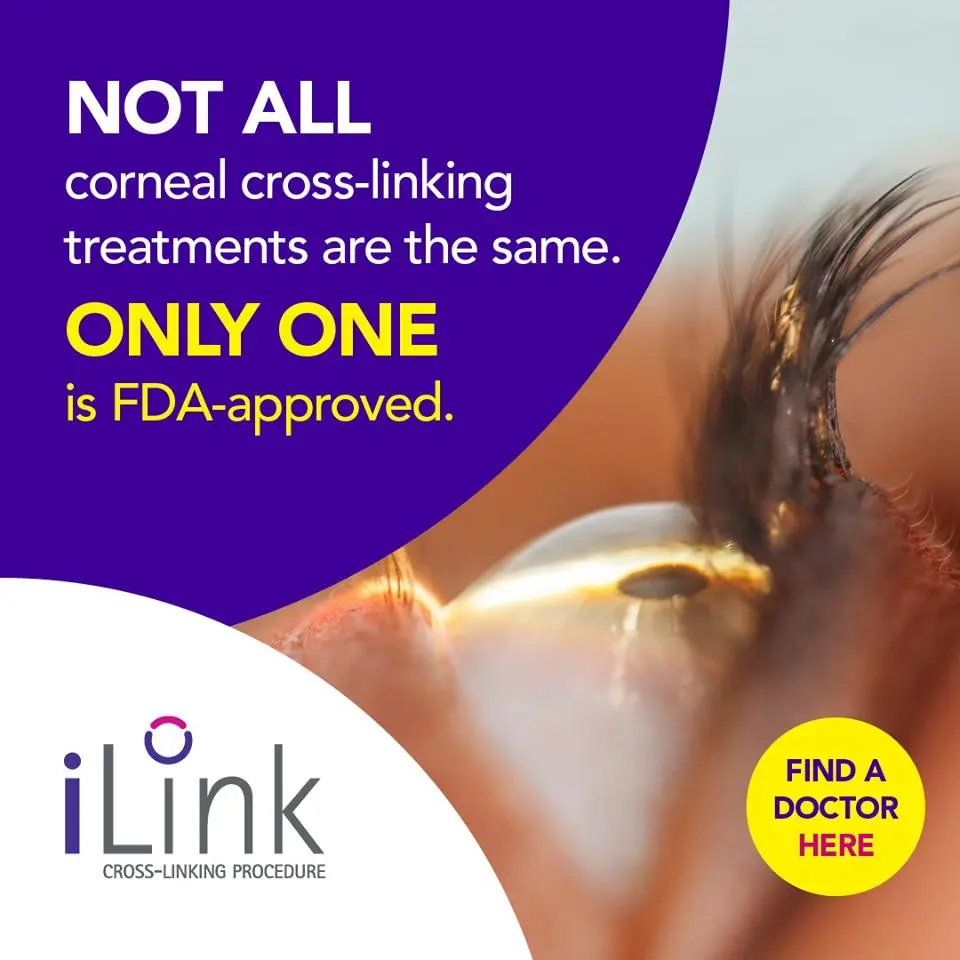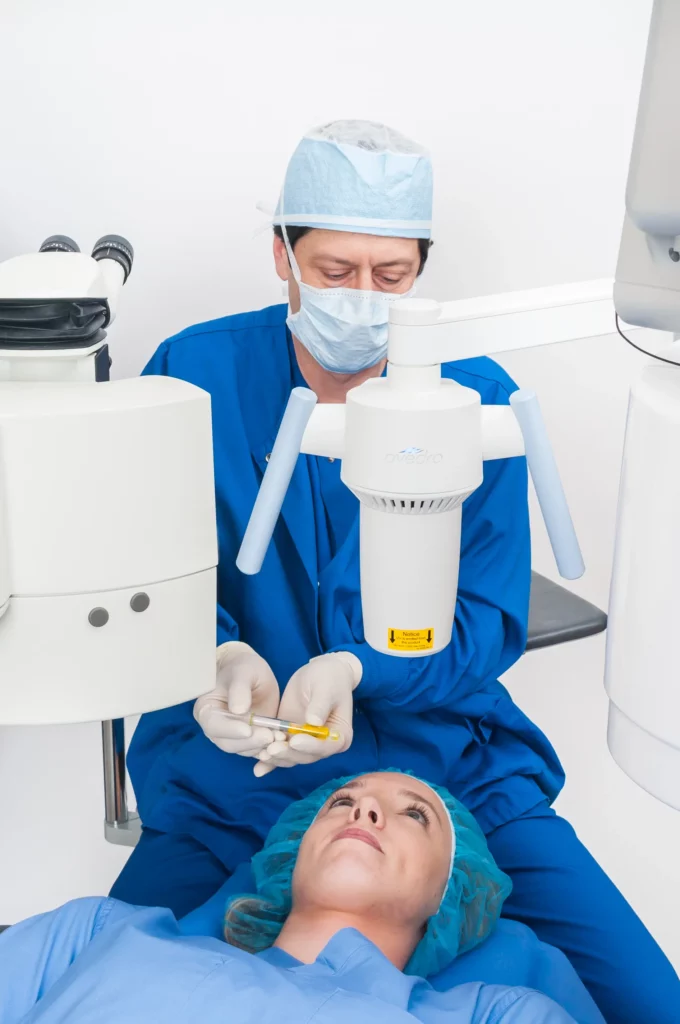The Importance of Receiving iLink® FDA-Approved Cross-Linking

After being diagnosed with keratoconus and receiving information on the condition and available treatment options from their doctor, the first thing most people do is head to the internet to do additional research. There, they’ll discover more about keratoconus, connect with others who are also living with the condition, and learn more about the treatment options their doctor recommended, including glasses or contact lenses, a corneal transplant, Intacs, or corneal cross-linking. While many people decide to start off with contact lenses to help improve their vision, the lenses ultimately do not treat the underlying condition, and it is likely that the keratoconus will continue to progress. This is where cross-linking comes into play.
iLink® FDA-approved cross-linking is the only treatment option proven safe and effective in slowing or halting the progression of keratoconus to help preserve patients’ vision. This minimally invasive, outpatient procedure combines the use of prescription eye drops, Photrexa® Viscous (riboflavin 5’-phosphate in 20% dextran ophthalmic solution), Photrexa® (riboflavin 5’-phosphate ophthalmic solution), and ultraviolet A (UVA) light from the KXL® system to treat progressive keratoconus. It works by creating new collagen cross-links and leads to the stiffening of the cornea. Read the safety information below and talk to your doctor about the risks and benefits of iLink.
It is important to know that the iLink epi-off procedure is the ONLY cross-linking treatment approved by the FDA (since April 2016) and eligible for insurance reimbursement. There are other cross-linking procedures being offered that are unapproved, so it is imperative to understand that NOT ALL corneal cross-linking treatments are the same. A doctor may offer corneal cross-linking, but that does not necessarily mean that it is FDA-approved cross-linking. Continue reading to understand the key differences between FDA-approved iLink and unapproved procedures, including why iLink is the only procedure eligible for insurance coverage, and how to verify that your doctor is offering the FDA-approved iLink procedure.
Key Cross-Linking Terms
Before we begin, it’s important to know the difference between FDA-approved iLink and unapproved cross-linking. To help, we’re breaking down some common cross-linking terms that you may or may not already know:
- Epi-Off Cross-Linking: Epi-off cross-linking requires the removal of the epithelium, the outermost layer of the cornea, to assure deep penetration of the riboflavin eye drops. iLink epi-off cross-linking performed with Photrexa Viscous, Photrexa, and the KXL System has been rigorously tested and is the ONLY cross-linking procedure approved by the US Food and Drug Administration (FDA).
- Epi-On Cross-Linking: Epi-on cross-linking is an investigational procedure where the epithelium is left intact. There are currently no FDA-approved epi-on cross-linking procedures in the U.S.
- Holcomb C3R: Holcomb C3R is a marketing trademark for an epi-on cross-linking procedure. Neither the drug nor device used in the Holcomb C3R procedure is FDA-approved for use in corneal cross-linking.
The Importance of Receiving iLink FDA-Approved Cross-Linking
iLink cross-linking is FDA-approved, clinically proven, safe and effective. Unlike unapproved or investigational cross-linking procedures, the FDA-approved protocol requires the use of drug products that have been rigorously tested and are specifically controlled and manufactured in an FDA-registered facility and in compliance with all FDA guidelines. The safety of unapproved drugs and devices, has not been evaluated and their manufacturing process has not been evaluated. While manufacturers of FDA-approved drugs and devices are required to report adverse experiences to the FDA, there is no equivalent reporting required for unapproved products, which may present a risk to public safety. Below, we’re highlighting some of the key differences between iLink and non-FDA-approved cross-linking procedures.
| Category | iLink: the ONLY cross-linking procedure approved by the FDA | Non FDA-Approved, illegal or unregulated procedures |
|---|---|---|
| Drugs Used | Rigorously tested and controlled FDA-approved Photrexa®, Photrexa® Viscous | Riboflavin that has not been FDA-approved |
| Device Used | KXL® system, the only FDA-approved cross-linking device | Unapproved device used may have been modified or illegally imported, no post-market surveillance |
| Procedure | Epi-off procedure, validated in controlled clinical trials | Not FDA-approve; No standardized treatment approach |
| FDA Approved | Yes, for both Photrexa drug formulations and device used | No |
| Pivotal Clinical Trials | Yes, robustly studied procedure | No |
| # of US Procedures Performed Annually | >60K | Unknown |
| # of US Physician Performing Procedure | ~600 | Unknown |
| Adverse Event Reporting | FDA-mandated reporting & approved labeling with known risks/side effects (see prescribing information) | Side effects not tracked or monitored |
| Insurance Coverage | >95% commercial coverage; All 50 states have >6 plans covering iLink | No; fully out of pocket cash procedure |
| Typical Patient Out of Pocket Cost | Can vary based on your insurance plan: $0-$200 (iLink also has a copay assistance plan) | Varies. In some cases, patients have been charged as much as $4,000/eye |
Insurance Coverage For iLink FDA-Approved Cross-Linking
iLink FDA-approved cross-linking is widely covered by insurance and is THE ONLY cross-linking procedure that is eligible for insurance coverage in the United States. Specifically, greater than 95% of the commercially insured population has access to FDA-approved cross-linking, and United Healthcare, Anthem, Aetna, Cigna & Humana are among the many commercial plans that cover iLink.
Prior to undergoing cross-linking, make sure to:
- Confirm with your doctor that he or she will be performing iLink FDA-approved cross-linking with the Photrexa drug formulations and KXL System.
You can also find a list of doctors performing iLink on our physician locator. - Then, contact your insurance provider to confirm they cover iLink FDA-approved cross-linking.
If you do not have insurance and your doctor has recommended iLink FDA-approved cross-linking, there are various programs available to help, such as the Glaukos Patient Assistance Program. This program is offered by individual doctors and practices, in partnership with Glaukos, to help cover the costs of the procedure and the Photrexa drug formulations if a patient does not have insurance coverage. Contact your doctor to learn more.
How Do I Know if My Doctor is Performing iLink FDA-Approved Cross-Linking?

Not sure if your eye care professional is offering iLink FDA-approved cross-linking? Check our Physician Locator to see if your doctor is listed! Our locator tool will provide you with a directory to find an iLink FDA-approved cross-linking expert who is familiar with treating progressive keratoconus in your area.
Also, it’s important to ask your doctor what drug formulation and device they use for cross-linking and whether the procedure is FDA-approved or investigational. Remember: the only way they are performing FDA-approved cross-linking is if they are using Photrexa drug formulations and the KXL System.
Don’t Be Afraid to Get a Second Opinion
You may want to seek a second opinion if your doctor recommends a cross-linking procedure that has not been FDA-approved. iLink FDA-approved cross-linking is proven to be safe and effective in slowing or halting the progression of keratoconus to help preserve patients’ vision and is the only cross-linking procedure eligible for insurance reimbursement in the United States. If your doctor informs you that the procedure is not eligible for insurance coverage, it is likely that you are not receiving FDA-approved cross-linking and you should consider seeking a second opinion.
Here are some general guidelines to determine if you should seek a second opinion:
- Your doctor recommends a cross-linking procedure that has not been FDA-approved.
- Your doctor asks you to pay cash and submit to insurance on your own.
- Your doctor suggests that you pay for treatment as part of their own trial. (Clinical trials for FDA-approval are typically free to patients).
- Your doctor tells you that their cross-linking procedure is not covered by insurance.
Stay Informed!
If you or a loved one need to receive cross-linking to treat your progressive keratoconus, make sure you are receiving iLink – the ONLY FDA-approved cross-linking treatment available.
Don’t risk your vision on a product or procedure that does not have proven safety and efficacy. If your keratoconus is not effectively treated and continues to progress, you may lose vision that cannot be recovered.
The internet can be overwhelming, so if you have any questions, be sure to speak with your eye care professional or connect with others in the keratoconus community.
Follow us on Instagram, Twitter, and Facebook for more information regarding your keratoconus journey or iLink FDA-approved cross-linking.